Dealership Transparency: The Key to Customer Trust
Building Trust Through Honesty
Shoppers are savvier these days than ever, and in an increasingly competitive marketplace like auto sales, it’s that much more important for dealerships to provide all the information they can on the conditions of vehicles on their lot. This trend is driven by a number of factors, including increased competition between auto dealers themselves, and growing consumer awareness around automotive marketing tactics.
Regardless of the reasons behind this shift, car dealers that embrace transparency will be better positioned to connect with today’s discerning buyers and gain their all-important trust. Building that trust with buyers starts with upfront clarity, and there are few better ways to do that than by being clear about any significant damage present on a vehicle prior to the customer finding it themselves.
It's A Balancing Act
When it comes to displaying damage on used cars in particular, auto dealerships would be best served by trying wherever possible to strike a balance between appearing to hide information, and providing too much. This often means highlighting the two to five most significant areas of wear and tear. This will help build trust with potential customers by being transparent and upfront about the condition of the vehicle. However, dealerships don’t need to show every little detail in order to be trusted.
In fact, too much information can actually overwhelm customers and turn them off from making a purchase. The key is to provide just enough information to show that you’re being honest and transparent about the vehicle’s condition. By following these best practices, auto dealerships can develop a trusting relationship with potential customers, which naturally increases their chances of making a sale.
Be Mindful of Laws & Regulations

The laws and regulations that surround documenting damage to a vehicle prior to a sale vary widely from state to state, but in general auto dealerships need to be aware of their specific state’s requirements to keep them protected. They should also have a clear and concise process for documenting that damage, so that customers can easily understand what they’re looking at when shopping online or on the lot.
Clear photos and descriptions of the damage are essential, as is highlighting the most significant areas of wear and tear, though the ways this can be done online also vary pretty widely. Most of the time, including this information in the vehicle’s description is sufficient, though there are some digital platforms that can assist with this. Either way, it’s critical to understand what customers are generally going to look for and make sure those elements are well-covered.
What Customers Look For
As mentioned, customers generally have an idea of the main types of damage they’re looking out for when shopping for a new or used car. A test drive will often bring to light small and easily addressable things like missed maintenance (e.g. squealing brakes, a touchy clutch, etc.), but there are a few important things you’ll want to make sure you have documented:
Exterior cosmetic issues like dents and scratches on the body of the car
Worn down or cracked tires
Interior items like damaged upholstery or carpets
Significant engine damages or repairs
As we’ve said, if auto dealerships are honest about a car’s damage, it can go a long way in gaining customer trust. In addition, being upfront about damage can also help save time in the negotiation process, which keeps your sales staff productive. Bear in mind that while you don’t need to share every minor detail on every vehicle’s description, there are outside services customers often use (we’ll use Carfax as an example) that could show important previous damages – you’ll definitely want to make sure to be upfront about these, or you risk breaking your hard-won trust. The good news is, tools like Carfax can actually often help dealerships during the sales process.
How Can Dealerships Use Carfax to Sell More Cars?

There is no single answer to this question, as car dealerships may use Carfax reports for a variety of reasons. Some dealers may use these reports to simply check for any pre-existing damage or repairs on a used vehicle, while others may use them to detect issues with the vehicle’s history or ownership.
Anything found here should generally be recorded and addressed as early as possible so customers don’t feel like you’re trying to hide anything.
Additionally, some auto dealers may rely on Carfax reports in their marketing efforts, using them to help promote the quality and reliability of their vehicles to potential buyers. You’ve probably seen dealers advertising how upfront and transparent they are by leveraging these reports, and that’s not a bad idea in general.
Regardless of the reason, it is clear that Carfax reports have become an invaluable tool for auto dealerships looking to build trust and credibility with their customers. And many customers these days are going to ask for these reports during negotiation anyhow, so in most cases, it’s a no-brainer.
The Takeaway:
As we’ve shown, car dealerships have seen considerable success in recent years by embracing transparency and openness when it comes to vehicle damage. In many cases, it becomes a value proposition and can be a valuable marketing tool. By providing customers with detailed information about any pre-existing damage or repairs before they arrive at your lot, auto dealers are able to build trust and credibility among their buyers – and drive more sales.

Redline is dedicated to helping modern dealerships engage, communicate with, and cater to modern, tech savvy car shoppers. Our unique proprietary suite of products and services optimizes and redefines how automotive dealers reach, retain, market, and sell to customers — front end, back end, all ends.

